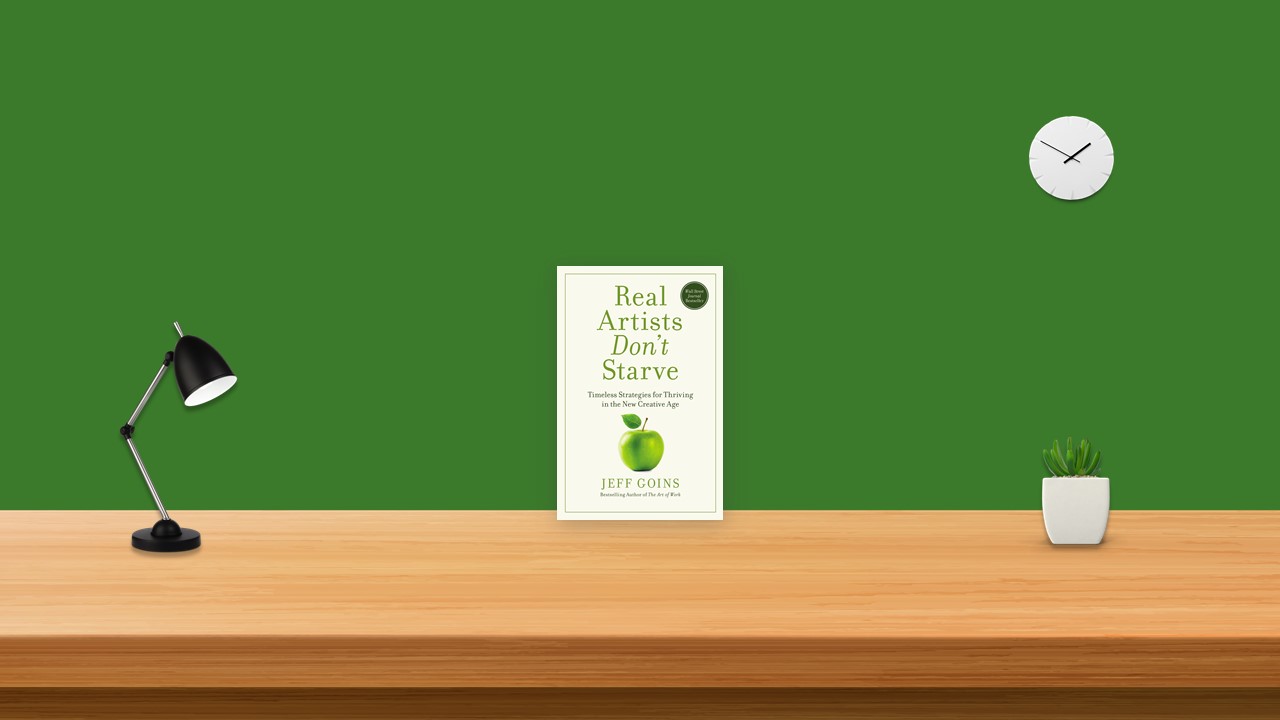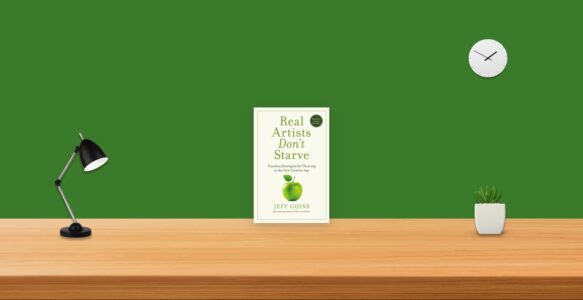You Aren’t Born an Artist
The Starving Artist Believes You Must Be Born An Artist. The Thriving Artist Knows You Must Become One.
The first step in letting go of the Starving Artist mentality is to let go of who we think we are or must be, even if we have no idea what new identity awaits us. What’s out there, however scary it may be, is almost certainly better than staying where we are now.
Art is always found on the fringes, at the edge of our discomfort where true change occurs. It’s never too late to start living a new story. You just have to become who you are, taking small steps along the way.
Stop Trying to Be Original
The starving artist strives to be original. The thriving artist steals from his influences.
When you steal, don’t just copy and paste the work of your predecessors. Once you have mastered the form, bring those influences together in a new way. Curate before you create. If you do this well, you won’t be merely cribbing other people’s work and passing it off as your own. You will be building on it and making it better.
Creativity starts with stealing, but it does not end there. The creative process, when done right, culminates in something so interesting, that others are now compelled to steal from you. That’s when you know you’ve done your job: you are no longer the thief but the one being robbed.
Apprentice Under a Master
The starving artist believes talent is enough. The thriving artist apprentices under a master.
You must be courageous enough to reach out to a master but at the same time hardworking enough not to waste his time. When things don’t go according to plan, do what must be done. And when it doesn’t work out, be persistent. Keep showing up, regardless of the outcome. Opportunities may come and go, but in the end, hard work is all we can measure.
Artists starve because they think they can make it on their own, ignoring the need for a teacher. Thriving Artists, on the other hand, are both humble enough to admit their need and audacious enough to seek it out. Great work is not a result of luck but of a willingness to become an apprentice.
Harness Your Stubbornness
The starving artist is stubborn about everything. The thriving artist is stubborn about the right things.
Sometimes, when we see a creative person succeed, we dismiss his breakthrough as luck or the result of pure talent, but neither explanation is accurate. What often allows great work to get the attention it deserves is not a matter of only talent or luck but a matter of the will. Can you stick around long enough to see your work succeed? Do you have enough grit to take a few critical hits and keep going? Or will you get discouraged at the first sign of failure?
You must be willing to keep going, even in the face of adversity. On the surface, stubbornness may look like a liability, but in creative work, it can be an asset. A little tenacity can fuel our pursuit of excellence, giving us the grit we need to create lasting work.
Flexible on details, but stubborn on vision, as Jeff Bezos would say.
Cultivate Patrons
The starving artist waits to be noticed. The thriving artist cultivates patrons.
Finding a patron is a lot like finding a master: we put ourselves in the place where opportunity happens, making sure we have developed our craft so that we do not waste the person’s time. When we knock on their doors, we need to be ready to receive what they have to offer. Most likely, we will not find these patrons far off. Often, they are in our own backyards, down the street, or around the corner. Sometimes they are even in our day jobs. Other times they are the relationships we may be neglecting, the loose ties with friends and acquaintances that could lead to a breakthrough. We just need to recognize them.
You can’t succeed alone. We all need someone to invest in our work. Without a Sam Phillips, we don’t get an Elvis Presley. We also don’t get a Jerry Lee Lewis or a Howlin’ Wolf. As Johnny Cash once said, “If there hadn’t been a Sam Phillips, I might still be working in a cotton field.”
Without a patron, you’re rolling the dice, hoping for the best— and the world is unkind to such gambles.
Go Join a Scene
The starving artist believes he can be creative anywhere. The thriving artist goes where creative work is already happening.
Scenes and networks are all around us, but they will not come find us. We must move. Whether that means moving across the room or around the globe, a willingness to step out of our comfort zone is the first step toward finding the place and the people who will help our work thrive.
Show up and be seen. Go to a coffee shop or a conference or maybe make the move to a new city altogether. Join the scene, and find that group of people you need to succeed.
Success in any creative field is contingent on the scenes and networks you are a part of. You join the scene, showing up and sharing your work. But you build a network by giving more than you take. A network is not made by just connecting with the right people, but by connecting those people to each other. It’s not just who you know—it’s who you help. As you make these contributions, what you will create is a group of relationships—a network—that you can take with you wherever you go.
Practice in Public
The starving artist doesn’t share his work. The thriving artist practices in public.
When you practice like that, sharing your work for the world to see, you develop more than just a reputation. You build a legitimate fan base around your work.
Led Zeppelin offered their music to the world as a gift and partnered with their audience to share it. For years, they’d been experimenting with new forms of rock—all in front of an audience. And here was the greatest experiment yet. Could their art live without their name attached to it? Apparently, it could, but perhaps the bigger question is, could it have succeeded without the audience? It’s doubtful.
When we sincerely offer our gifts to the world, not through hype but by practicing in public, the world often repays us by first taking notice and then responding with loyalty. We get better, earning an audience that will allow us to continue creating for years to come.
Don’t Work for Free
The starving artist works for free. The thriving artist always works for something.
Some artists tend to think making money is either a system you sell out to or something to be avoided altogether. But in reality, it’s neither. If you don’t make money, you won’t have any art to make. We must seek to better understand the business of being an artist. Ignoring this reality is the fastest route to stop creating altogether. To be an artist is to be an entrepreneur. We must learn to embrace this tension and the beauty that comes from it.
Your work matters. But the world won’t recognize this until you do. You have to avoid the temptation to give all your work away for free, believing it will somehow lead to compensation. It won’t. Those opportunities often leave the artist feeling frustrated and bitter.
This is not to say you can’t be generous or that you should be arrogant, but there’s nothing wrong with seeing the value in your work.
Own Your Work
The starving artist sells out to an early bidder. The thriving artist owns his work.
We must hold out for as long as we can, being careful not to sell out too soon. It’s not that selling out is bad. But selling out in the wrong way, at the wrong time, and for the wrong reasons, is what we need to avoid.
At some point it may make sense to give up some rights to your work and let go of creative control. If such an opportunity earns you the chance to do more of the work with fewer financial constraints, do it. Just remember these occasions are rare and ought to be approached with caution. We should not forget that when we trust others to act in our best interest, we are betting on a system that is not working for us.
Diversify Your Portfolio
The starving artist masters one craft. The thriving artist masters many.
Being distractible can be a strength in creative work. When we understand that an open mind can guide us into new possibilities, we don’t have to try to change ourselves into being more organized or “responsible.” Instead, we can use our creative quirks to our advantage, helping us identify opportunities to do fulfilling work that we would have otherwise missed.
“The negative,” says Mark Frauenfelder is that “you tend to get spread out a little too thin and maybe you don’t master certain things as well as other people who are obsessively focused on something. I wouldn’t necessarily recommend being a jack-of-all-trades. But I think it’s worked for me, and I’m happy living a life of exploring different ways to be creative and try to make a living at the same time.”
Of course, juggling so many things can be difficult, and there are real costs to a life filled with diverse interests, but when you understand this is not an event but a process, the work becomes richer. When we focus on the big picture, we create for ourselves and the world a portfolio worth noticing and remembering.


